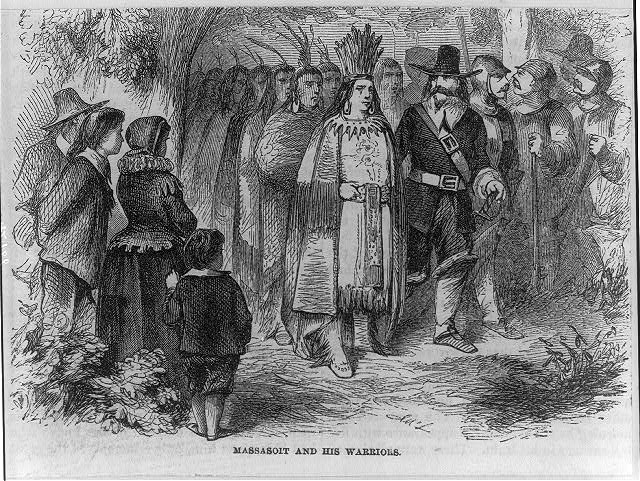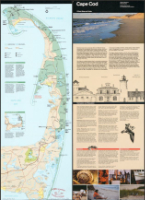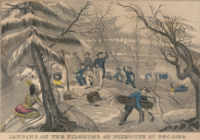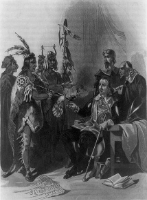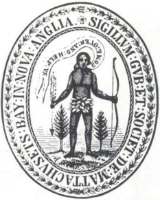Primary Source Learning: The Wampanoag, the Plimoth Colonists & the First Thanksgiving
This primary source set is targeted to elementary students and includes background information and thinking prompts. It was curated mainly by Dr. John Bickford, Professor of Social Studies/History Education at Eastern Illinois University and Editor-in-Chief of The Councilor: A Journal of the Social Studies, with the goal of helping students separate Thanksgiving myths from history.
This set is also available as a Google document; get it here. Access the teaching guide for this source set.
Source 1
Pre-reading: Pilgrims are people who go on a long journey, often to a foreign land [different country]. When they settle [stay] in the new place, they are called colonists. The people we think of today as “Pilgrims” did not use that word. Instead, they called themselves:
- Saints (they thought they were pretty awesome)
- Separatists (they wanted to be separate from other people who weren’t Saints)
- Leideners (from the town in Leiden, Holland where they went after leaving England)
A very long time ago (more than 500 years), this group of people left England for Holland for religious reasons. They stayed there for 12 years and then decided to try farming in North America. The group set sail on a ship [boat] called the Mayflower in September, 1620. Instead of landing near the Hudson River in New York as they had planned, they came ashore on Cape Cod, Massachusetts in November, 1620. This 1997 map shows the area.
Cape Cod National Seashore, Massachusetts
Thinking prompts: Scan the last paragraph of the text in the top, right box on the map. (1) Where did the “Pilgrims” land? (2) What do you notice about the geography near the landing? (3) Why do you think they might have selected this spot to stop at first? (4) Where did the colonists go next?
Source 2
Pre-reading: This is a map of the area where the Native American people called the Wampanoag lived around the year of 1620.
Territory of the Wampanoag circa 1620
Thinking prompts: (1) What do you notice about the area? (2) Compare this map to a modern day map of the area. What more did you learn from comparing the two maps?
Source 3
Pre-reading: We often see pictures of “Pilgrims” dressed in all black. But according to the Plimoth Patuxet Museums, “Everyday clothes were made of many colors. Brown, brick red, yellow and blue were common.” Men usually wore shirts under tight-fitting jackets that were attached to knee-length pants. They also wore long stockings [like socks] over their knees and boots or shoes. They almost always wore big hats and in colder weather they wore long cloaks or coats.
The Wampanoag wore breechcloths and, during the colder months, mantels, a type of robe or coat made of deerskin or animal fur fastened at one shoulder and tied at the waist. They also wore leggings and moccasins, a type of shoe made from animal skin. They painted their faces and wore lots of decorative objects, kind of like jewelry. Keep this information in mind as you look closely at this picture created more than 200 years after the colonists arrived in Plymouth.1
Landing of the Pilgrims at Plymouth
Thinking prompts: Compare how the people in this picture are dressed with the descriptions of clothing you just read about. (1) What similarities do you notice? (2) What differences do you see?
Source 4
Pre-reading: The site the colonists chose was an abandoned [nobody was living there] Wampanoag settlement [like a village]. Many of the Native Americans who had lived there died from disease between 1616-1619.
While the colonists built their houses, the group lived on the ship. The winter of 1621 was very hard and almost half of the people died. This photo is an aerial view (taken from a helicopter) of the reconstructed [remade] “Pilgrim Village”. It is one of the sites of the Plimoth Patuxet Museums. Notice the difference between our spelling of the town, Plymouth, Massachusetts and the colonists’ spelling of their colony, Plimoth.
Aerial View of Plimoth Plantation Reconstruction
Thinking prompts: Look closely at the photo. (1) What do you notice about the geography? (2) Why do you think the village was shaped this way?
Source 5
Pre-reading: The colonists sometimes saw the Natives but the groups did not talk at first. When they did talk in the spring of 1621, the colonists made a treaty [agreement] of protection with the Wampanoag leader who is known today as Massasoit. The agreement had six points:2
(1) neither group would hurt the other but (2) if someone did, the group whose member was hurt could punish the offender (person who broke the agreement); (3) if anything was stolen from one group it would be returned and the thief would be punished by their own group; (4) neither group would bring weapons to meetings but (5) they would help protect each other against each group’s enemies, and (6) would send representatives to the group in trouble.
This artwork, which was created more than 250 years after, shows the signing of the treaty.
Meeting of Governor Carver and Massasoit
Thinking prompts: Look closely at this image. (1) What do you notice about how each group is depicted (shown)? (2) Do the groups seem like equals? (3) What details from the image support your conclusion? (4) Since this source was created so long after the event it shows, do you think it is accurate? (5) Why do you think so?
Source 6
Pre-reading: After a successful harvest [they grew and collected a lot of food] in the fall of 1621, the colonists celebrated for 3 days. According to the Plimoth Patuxet Museums, “Massasoit and 90 of his men joined the English for feasting [eating and drinking] and entertainment.”3 More than 200 years later, this famous celebration was remembered as the First Thanksgiving.
A colonist named Edward Winslow wrote about the first Thanksgiving in a letter to a family member on December 12, 1621. This was about a month after the first Thanksgiving.
Modified excerpt from a letter4
We have our harvest of food. Our governor [leader] sent four men to hunt for birds so we could celebrate. These four men got as many birds as we could eat for a week. At this time, we celebrated for three days with the Wampanoags and their great king Massasoit. They brought five deer to share with us. Thank God! We have much to eat.
Thinking prompt: (1) What did you learn from this primary source?
Source 7
Pre-reading: A colonist named William Bradford wrote a book called History Of Plymouth Plantation.5 It was published in the 1640s, about 20 years after the first Thanksgiving.
Modified excerpt from a book6
The Pilgrims began to gather a small harvest and prepare for winter. We were healthy and strong and had a lot of food. Some went hunting for deer, water birds, and wild turkeys. Others went fishing for cod, bass, and other fish. Every family had a good amount of Indian corn. All summer no one was hungry. Afterwards, many Pilgrims wrote true stories about how much food they had to their friends in England.
Thinking prompt: (1) What are the similarities and differences in the stories told by this primary source and primary source 6?
Source 8
Pre-reading: A colonist named William Hilton was not at the first Thanksgiving but he wrote about the food of the area in a letter to his cousin in November, 1621.
Modified excerpt from a letter7
The country is very pleasant and temperate [not too cold], with a lot of fruits and vines. There are also walnuts, chestnuts, small nuts and plums, and many kinds of flowers, roots and herbs. No place has more gooseberrries and strawberries, nor better. Timber [trees] covers the land that is filled with all kinds of animals, and great flocks of turkey, quails, pigeons and partridges; many great lakes are full of fish, fowl [birds people eat], beavers, and otters. The sea has all sorts of excellent fish. There is no better grain than the Indian corn.
Thinking prompts: Think about the foods mentioned in this primary source and in primary source 6 and primary source 7. (1) What foods do you think they ate at the first Thanksgiving? (2) What foods do you eat at Thanksgiving?
Source 9
Pre-reading: This is the Massachusetts Bay Colony’s original seal, which is kind of like a flag. It uses words and symbols [pictures of objects that show meaning]. This seal shows a Native American holding a downward-pointed arrow (a symbol showing peace) with the words “COME OVER AND HELP US” (showing that the colonists and Wampanoag were working together).
Great Seal of the Commonwealth of Massachusetts
Thinking prompts: (1) Do you think this is an accurate (true) representation of the relationship between the two groups? Use details from the primary source to support your conclusion. (2) Why is it important for citizens to know history? (3) Think about all that you have learned about the colonists, the Wampanoag, and the first Thanksgiving. Would you create a new seal to reflect [represent] what you have learned or just add or change a few details? Write down some ideas. (4) Draw your version of this historic seal and describe the symbols you used and why you chose to include them. (5) Create a seal that represents you or your family.
* Fun fact: Every U.S. state has a seal. Find your state seal.
1 Clothing descriptions adapted from: https://plimoth.org/for-students/homework-help/what-to-wear, accessed 11/21
2 Adapted from: https://www.newenglandhistoricalsociety.com/massasoit-visits-plymouth/, accessed 11/21
3 Accessed 11/21 from: https://plimoth.org/for-students/homework-help/who-were-the-pilgrims
4 “Relation or Journal of the Beginning and Proceedings of the English Plantation Settled at Plimoth in New England, by Certain English Adventurers, Both Merchants and Others, 1622,” in the Collections of the Massachusetts Historical Society, Second Series (Boston: W. L. Lewis, 1832), 62–63. Accessed 11/21: https://www.gilderlehrman.org/sites/default/files/inline-pdfs/Edward%20Winslow%20letter%20abridged.pdf
5 Adapted from: https://pilgrimhall.org/ap_first_thanksgiving.htm
6 History of Plymouth Plantation, accessed 11/21 http://hdl.loc.gov/loc.gdc/scd0001.00140691355
7 Adapted from Primary Sources from the First Thanksgiving, p. 2, Pilgrim Hall Museum: https://www.pilgrimhall.org/pdf/TG_What_Happened_in_1621.pdf, accessed 11/21
Related resources

